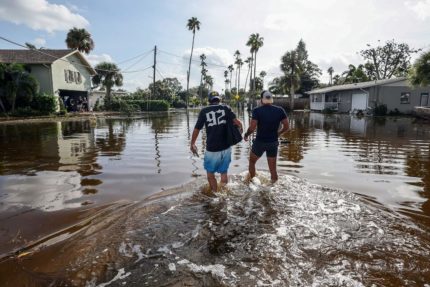Hurricane Milton has continued to rapidly intensify in the Gulf of Mexico, transforming from a tropical storm to a hurricane as of Sunday afternoon. The National Hurricane Milton Center (NHC) has confirmed that the storm is on course to make landfall along the west coast of Florida by midweek, potentially causing widespread destruction. Meteorologists are closely monitoring Hurricane Milton as it strengthens, with concerns that it may reach Category 4 status before hitting the Florida Peninsula.
The NHC warns that life-threatening storm surges, destructive winds, and heavy rainfall could hit portions of the west coast of the Florida Peninsula by late Tuesday or Wednesday. In response, hurricane and storm surge watches are expected to be issued later on Sunday for key areas. Meanwhile, tropical storm watches and warnings have already been issued for portions of Mexico’s Yucatan Peninsula. Residents along the Florida Gulf Coast are advised to know their evacuation zones and prepare for potential power outages in the coming days.
Current Location and Path of Hurricane Milton
As of Sunday afternoon, Hurricane Milton is swirling over the Gulf of Mexico, about 300 miles northwest of the Yucatan Peninsula. The storm is tracking eastward, and it is expected to take a northeastward turn toward the Florida Peninsula before moving into the Atlantic. According to the latest computer models, the system will likely intensify into a major Hurricane Milton, threatening much of the Florida Gulf Coast.
While National Hurricane Milton Center is projected to pass south of the Florida Big Bend, some areas could still experience storm surges. Pinellas County to Naples is particularly vulnerable, with surges potentially higher than those seen during Hurricane Helene. Although hurricane Milton’s surge impacts may not rival Helene’s in northern regions, southern coastal communities should remain vigilant as the hurricane advances.
Potential Impacts: Flooding, Wind Damage, and Rip Currents
Heavy rainfall is expected to arrive in Florida well before Hurricane Milton makes landfall, with scattered showers already sweeping across the peninsula on Sunday. Flood watches are in place for much of the region, and rainfall totals could reach up to a foot in some areas. Most of the Florida Peninsula should brace for at least three inches of rain by Wednesday, raising the risk of localized flooding, especially in low-lying areas.
Wind damage is another significant concern. Hurricane Milton is forecasted to reach Category 4 strength before weakening slightly to a Category 3 hurricane just ahead of landfall. However, residents along the west-central and southwest Florida coasts are urged to prepare as if a Category 4 or 5 storm is imminent. High winds could begin late Tuesday or early Wednesday, making hurricane preparations potentially hazardous after that point. The intensity of wind damage will depend on how much Hurricane Milton strengthens, as wind shear in the northern Gulf of Mexico might slow down its intensification.
Rip Currents and Other Hazards
Aside from wind and flooding, Hurricane Milton also poses a serious rip current threat. Florida’s Atlantic Coast will experience strong onshore winds through the weekend, which could create hazardous rip currents even in the absence of rainfall. Similarly, the Gulf Coast, particularly from Tampa southward, may face a rip current threat early in the week as Hurricane Milton approaches.
October is a prime month for tropical development in the western Caribbean and Gulf of Mexico, with warm waters fueling hurricane formation. As Hurricane Milton continues to intensify, residents in affected areas should remain informed, finalize emergency plans, and stay alert for official updates from meteorological authorities.














